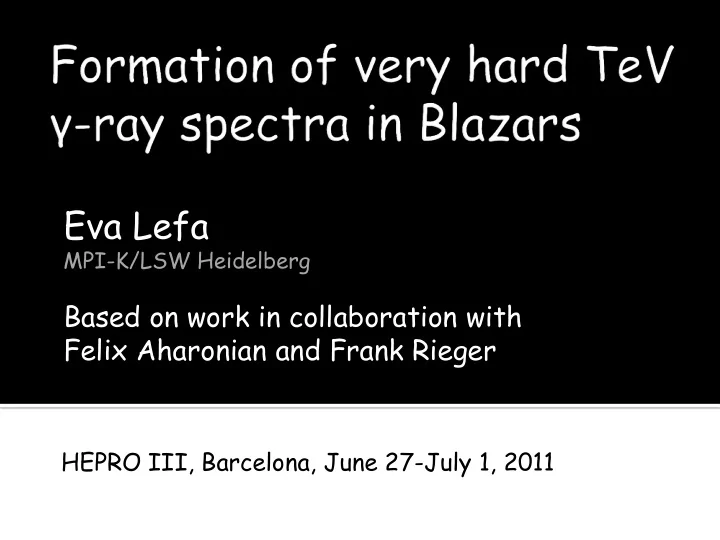

Eva Lefa MPI-K/LSW Heidelberg Based on work in collaboration with Felix Aharonian and Frank Rieger HEPRO III, Barcelona, June 27-July 1, 2011
EBL and very Hard Gamma-ray spectra of Blazars Solution/interpretation through standard leptonic scenarios Self-consistent Synchrotron self-Compton model • power- law distribution with high “low energy cut - off” in an expanding source • Relativistic maxwellian-like distributions External Compton scenario
Blazars ’ TeV photons interact with EBL via Deformation of the emitted spectrum E e -2 electron index E γ -1.5 TeV photon index (Thomson) and steeper for Klein-Nishina regime Aharonian et al. 2006 The spectra of some sources appear very hard with photon index Γ≤ 1.5 even for the lowest level of EBL (1ES1101- 232,1ES0229+200…)
“Exotic” scenarios Lorentz invariance violation ( Kifune 1999 and others) DARMA scenario (De Angelis et al. 2009) “Astrophysical” scenarios Secondary γ -rays from CR protons (Essey et al. 2011) Up-scatter of CMB photons from extended jet (Bottcher et. al 2008) Cold ultrarelativistic wind ( Aharonian et al. 2002 ) Internal absorption ( Aharonian et al. 2008, Zacharopoulou et al. 2011 ) Within standard leptonic models? (homogeneous, 1-zone SSC) We need hard electron energy distributions relativistic shocks/shear flows can produce distributions harder than (eg. Derishev et al. 2003, Stecker et al. 2007) BUT: any hard injection spectrum of electrons, after radiative (synchrotron or Thompson) losses, gets a standard form “E e -2 ”
Katarzynski et al. 2007 : homogeneous 1-zone SSC model of power-law electrons with large value of electron minimum cut-off Hardest possible index at TeV range ( Tavecchio et al. 2009 for 1ES 0229+200 with γ min ~5.10 5 ) Tavecchio et al. 2009 Electrons develop a γ -2 wing below γ min due to synchrotron losses • Very low magnetic field (B ~ 4.10 -4 G) • Practically no cooling • Extremely large electron energy density expansion of the source ?
Need to consider time-depended solutions (for radiative losses Mastichiadis & Kirk ‟98, Coppi & Aharonian „99) Adiabatic losses dominate over synchrotron losses when e.g. B~0.1G, R~10 15 cm, γ <10 6 Spherical relativistic expansion with constant velocity R=R o +u(t-t o ) constant injection of power-law electrons time Solution to kinetic equation •
γ 0 at electrons ν 1/3 at synchrotron spectrum injected γ 0min contribution dominates at low energies hard slope can remain at TeV (for timescales relative to the source size) and relax assumptions for the parameters (B~0.1 G) time Cut-off frequencies drop: Adiabatic cooling: due to MF reduction Synchrotron cooling: due to evolution of γ min
B~0.1G, R~10 15 cm, γ min ~5.10 5 In reality synchrotron losses may alter the electron distribution at high energies higher than raises with time so if then no modification at the hard TeV range
Narrow distributions, Minimum cut-off ? Stohastic acceleration + synchrotron losses ( Schlickeiser 1985, Aharonian et al. 1986, and investigated later for modeling blazars e.g. Saugé & Henri 2004; Katarzynski et al. 2006, Giebels et al. 2007...) Steady state solution to Fokker-Planck equation : • relativistic Maxwell-like distribution Cut-off energy: at balance • between acceleration and losses, can take values of ~10 5 and more
γ c =1.5 10 5 γ‟ c =3 γ c B=0.08 G R=5.10 14 cm (B/Bcr) γ 3 c >>1 Compton peak at the electron cut-off energy F ν ~ ν 1/3 at TeV range (very good agreement with narrow power-law) B-field of the order 0.1G (more reasonable parameters) Energy losses under account
TeV data obtained with HESS, corrected for 2 EBL models of Francheschini, high level-red points, low level – green
Electrons up-scatter external photon field, e.g. disk photons (of planckian distribution) after reprocessed/rescattered by BLR clouds In ECS scenarios we can get even harder spectra F ν ~v at TeV range B=1G γ c =4.10 4 T~2. 10 4 Γ=1 3
Combination of narrow distributions, e.g. 3-4 blobs with maxwellian-like electrons of different “temperatures” γ c and same parameters Same energy in each blob -> power-law like spectra of index 2 EED SSC spectrum Hard features may arise in the spectrum if the energetics of a single component change: very different γ c , more energy, different doppler factor…
Neronov et al. 2011: 30 days very hard flare with photon index Γ=1.1 at 10-200 GeV , no variability below 10 GeV ( Γ =1.8) Neronov et al. 2011
Neronov et al. 2011: 30 days very hard flare (photon index Γ=1.1 ) at 10-200 GeV , no variability below 10 GeV ( Γ =1.8)
Even very hard spectra can be approached within standard emission scenarios under certain assumptions Limiting case for SSC is F ν ~ ν 1/3 , for ECS F ν ~ ν 1 Narrow power-law electrons + adiabatic losses: recover the hard TeV spectrum, higher MF Maxwell-like electron distributions can form naturally hard TeV spectra under radiative losses Thank you!
Recommend
More recommend